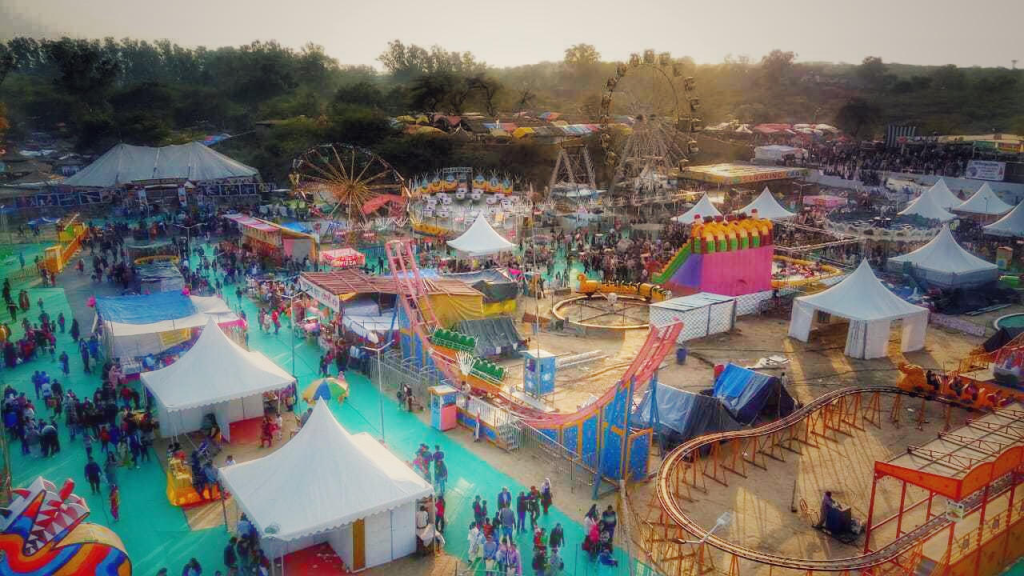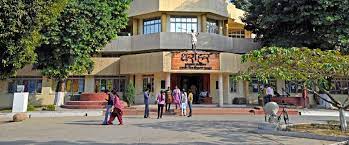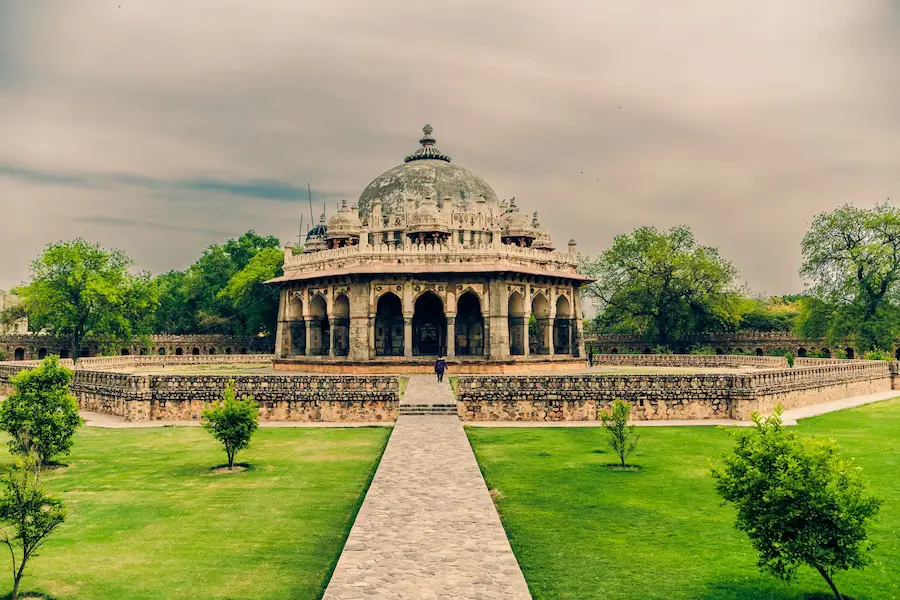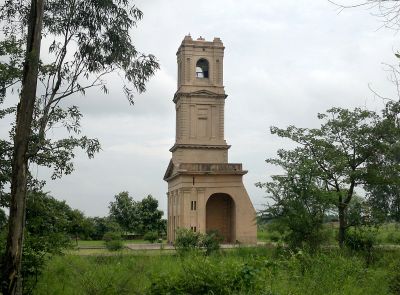Browse Items (153 total)
Sort by:
-
Firoz Shah Palace Complex
The edifice known as Firoz Shah’s Palace and tahkhana was built by Firoz Shah Tughlaq, the Sultan of Delhi (1351-1388 AD). Its arches are supported on sandstone carved pillars possibly belonging to some Hindu temples. The palace complex consists of an open courtyard surrounded by two and three-storied structures. A passage with steps leading to the terrace is embedded in the massive western wall of the palace. This passage was most possibly meant for guarding the roofs of the palace. It has several bastions with hollow cores and has a pillared hall connected with other rooms and cells of the palace. The red sandstone structures on the eastern side of the palace and the lotus tank on the terrace, however, are of much later origin.
-
Fort of Hansi
Though most of its walls and structures have now fallen, still some remains of that historical fort are surviving. This fort is more than 1,000 years old and the ancient fort was surviving till 1857, when its greater part was demolished. This building rests on 36 masonry pillars and arches with carved roofs. Now a huge 50 feet high mound is representing the ancient fort, all structures are on the top of the mound. It is a protect monument by Archeological Survey of India.
-
Fort of Prithvi Raj
A long pillared structure with a flat roof is situated on the top of the mound, which is called Baradari. The Gujjari Mahal was built by Firoz Shah Tughlaq for his beloved Gujri Rani, a native of Hisar with whom he fell in love during the course of one of his hunting expeditions. The palace imbibes characteristic features of Tughlaq architecture such as massive tapering walls thickly plastered in lime and narrow openings. Open stairs lead to the baradari (pavilion) of the palace, which stands on a high plinth and has underground chambers. The baradari is a square structure having three developed arches on each side. All entrances (except one) are provided with stone doorframes. The roof has nine bays, each carrying hemispherical dome decorated with panelling work in lime plaster. The exterior walls above the arched openings are provided with beautifully carved red sandstone brackets.
-
Gujari Mahal
The Gujjari Mahal was built by Firoz Shah Tughlaq for his beloved Gujri Rani, a native of Hisar with whom he fell in love during the course of one of his hunting expeditions. Open stairs lead to the baradari (pavilion) of the palace, which stands on a high plinth and has underground chambers. The baradari is a square structure having three developed arches on each side. All entrances (except one) are provided with stone doorframes. The roof has nine bays, each carrying hemispherical dome decorated with paneling work in lime plaster. The exterior walls above the arched openings are provided with beautifully carved red sandstone brackets.
-
Rai Bahadur Lala Murlidhar
Rai Bahadur Lala Murlidhar, known as the "Grand Old Man of Punjab," was a key figure in India's independence movement and among the founding members of the Indian National Congress. Born in 1850 in Ambala, Haryana, into an Aggarwal family, he settled there permanently in 1872.
A lawyer by profession, he was honored with the title of "Rai Bahadur" by the British government in recognition of his services. In 1885, he was the only representative from Punjab to attend the first session of the Indian National Congress in Bombay. The following year, he helped establish a Congress branch in Ambala, playing a crucial role in advancing the nationalist movement in the region.
After the Jallianwala Bagh massacre on April 13, 1919, Lala Murlidhar gave up his British-conferred titles, including "Rai Sahib" and "Kaiser-i-Hind," in protest against colonial rule. He passed away in 1924, leaving behind a lasting legacy in India's struggle for freedom.
-
Lala Lajpat Rai
Lala Lajpat Rai (1865–1928) was a prominent leader in India’s struggle for independence. Known as the "Punjab Kesari" (Lion of Punjab), he played a vital role in advocating for self-rule and resisting British colonial policies.
Early Life and Education
Born in Dhudike, Punjab, he pursued legal studies before dedicating himself to the national movement.
Role in the Freedom Struggle
A key figure in the Lal-Bal-Pal trio alongside Bal Gangadhar Tilak and Bipin Chandra Pal, pushing for self-governance.
Led efforts in the Swadeshi Movement, encouraging local industries and boycotting foreign goods.
Played an active role in the Non-Cooperation Movement and opposed British rule through peaceful protests.
Led a demonstration against the Simon Commission in 1928 and suffered injuries from police brutality, which later led to his passing.
Contributions to Society
Helped establish Punjab National Bank to support indigenous businesses.
Founded the Servants of the People Society to promote education and social reforms.
Advocated for education, women’s empowerment, and the upliftment of marginalized communities.
Legacy
His resilience inspired future revolutionaries, and his sacrifice remains a crucial part of India's history. His contributions are remembered every year on Martyr’s Day (November 17th).
-
Pt. Nekiram Sharma
Pandit Neki Ram Sharma was born on September 4, 1887, in Kelanga village, Rohtak district, Haryana. Pandit Nekiram Sharma was a well-known social reformer and political leader from Haryana, dedicated to improving the lives of farmers and promoting education. He was actively associated with the Arya Samaj movement and worked to advance social justice, self-reliance, and nationalist values.
He played a significant role in organizing the farming community, advocating for their rights, and opposing exploitative practices. His efforts in the cooperative movement and the establishment of educational institutions greatly contributed to the empowerment of rural society. Additionally, he was involved in India’s freedom movement, spreading awareness about self-governance and equality.
His contributions continue to inspire various social and educational initiatives in Haryana. He passed away on June 8, 1956.
-
Lala Kakaram
Lala Kaka Ram was an influential figure in Kaithal during India's struggle for independence. In 1932, he played a key role in the Civil Disobedience Movement by encouraging people to boycott foreign goods and participate in protests against British rule.
Apart from his political involvement, he was also known for his contributions to education and social welfare. He helped establish educational institutions in Kaithal, supporting the development of the community. His efforts in both the freedom movement and public service have left a lasting impact on the region.
As -
Babu Dayal Sharma
Babu Dayal Sharma was born in 1906 in Dharuhera village, which was then part of Gurgaon district and is now in Rewari district, Haryana. He played an active role in India's freedom struggle and was a key participant in the Praja Mandal movement in 1938, advocating for civil rights and responsible governance in princely states.
After India gained independence, he continued to serve the public and later became a minister in the Haryana state government. His contributions to both the independence movement and the political development of Haryana remain an important part of his legacy.

















